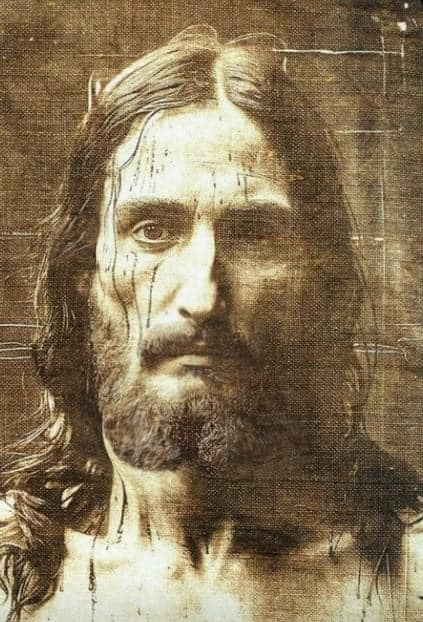By: Brian G. Chilton, M.Div., Ph.D. | August 25, 2024
Recently, the Shroud of Turin made news across the world as recent tests have indicated that the linen fabric dates to the beginning of the first-century AD. Continued tests have overturned the 1988 Carbon-14 dating that suggested that the cloth derived from medieval period.
Adding to the intrigue, artificial intelligence recently peered into the Shroud by depicting a detailed look at how the Man on the Shroud may have appeared. One particular program granted one of the most realistic portraits of the Man, eerily resembling a photograph of the late 1800s to early 1900s. Supporters and critics alike have stepped up to the plate to offer their endorsements or critiques of the image. Having researched the Shroud quite extensively over the past few years, it was noticeable how the majority of critics have not truly given themselves over to the current research of the Shroud.
Be that as it may, one of the most curious developments of these interactions stemmed from commenters who said, “I don’t think Middle Easterners look like that.” Or the image is too light or too dark for my taste. His hair is either too long or not long enough.
The Diversity of Middle Easterners
Most importantly, let it be said that Middle Easterners are extremely diverse. I have had the opportunity to meet many Jewish and Arab people living, or who have lived in the Middle East. It is downright offensive to purport that all Middle Easterners look the same. Some are lighter in complexion, others are darker. Some have straight hair, while others have short, curly hair. Keep in mind that the Middle East is found at the crossroads of three major continents: Asia, Africa, and Europe. Thus, the Middle East features a smorgasbord of various skin tones, body types, and hair styles, thereby showing the full creative genius of our God.
The Greater Theological Issue: In Whose Image Are We Striving to Become?
However, these conversations evoke a greater theological and spiritual problem in my mind. Regardless of what you do with the Shroud, have we become people who will critique the appearance of Jesus when we see Him? Will we stand before the Savior and say, “Jesus, why is your hair so long/short?” Will we concern ourselves that Jesus is taller or shorter than we envisioned?
Transformation that the Resurrection Brings
The most pressing issue is whether we seek to be made in the image of God, or whether we wish God to be made in our image. This is extremely problematic on various fronts. First, are we committed to following the impact that the resurrection brings? After the resurrection, Jesus said, “All authority in heaven and on earth has been given to Me. Go, therefore, and make disciples of all nations, baptizing them in the name of the Father and of the Son and of the Holy Spirit, teaching them to follow all that I commanded you; and behold, I am with you always, to the end of the age” (Matt. 28:18b-20).[1]
Make no bones about it, Jesus has always been a controversial figure because of His stance on justice, love, and truth. The Shroud, especially if it’s authentic, only highlights the controversy that will always surround the risen Savior. And rightfully so. If the resurrection is true, then everything changes, from the way we live our lives to the hope that we have in the afterlife. Are we committed to sharing the gospel message and living with the anticipated hope of our own resurrection?
Transformation that God’s Image Brings
Second, as believers, are we truly committed to following Jesus and being made in the image of God? Paul writes that we all, “with unveiled faces, looking as in a mirror at the glory of the Lord, are being transformed into the same image from glory to glory, just as from the Lord, the Spirit” (2 Cor. 3:18). Additionally, he teaches that those that God “foreknew, He also predestined to become conformed to the image of His Son, so that He would be the firstborn among many brothers and sisters; and these whom He called, he also justified; and these whom He justified, he also glorified” (Rom. 8:29).
Metamorphoo in 2 Corinthians 3:18
Both 2 Corinthians 3:18 and Romans 8:29 describe a change that God brings into the believer to make them into the image of Christ. In 2 Corinthians 3:18, Paul uses the word metamorphoo, which describes the changing of something from one form to a better one. Just as a caterpillar transforms into a beautiful butterfly, so the soul of a person is transformed from a worldly state into a spiritual one. Thus, it is important to note that our emotional and spiritual state is lacking and in dire need of transformation. Yet this cannot occur if we try to make God and Christ like ourselves. Instead, we must be made into the image of the incomparable, ineffable God.
Symmorphos in Romans 8:29
With Romans 8:29, Paul uses the term symmorphos. The term depicts one who is brought into compliance with another person or being. Even though all of humanity has been made in the image of God, that image was corrupted by the fall of Adam and Eve. Christ restored that image by His redemptive work on the cross and by His glorious resurrection. The work of Christ shows our desperate need to be conformed to the image of God rather than the other way around.
Conclusion
As we consider the sacrifice Jesus made for us, may we be inclined to cast away needless comparisons to attempt to make Jesus in our image. Most assuredly, even the one who is most like Jesus with His earthly body is far from who Jesus was in His perfect moral and spiritual state. All of us need to be transformed by God’s glorious grace. When seeing the scars on the full image of the Shroud with AI, the brutality of the cross becomes fully evident. Jesus did not die on the cross to leave us as we are. Rather, salvation ushers a change to our emotional and spiritual state, eventually leading to our own glorious resurrection. Thus, at the end of this reflection and regardless of whether the Shroud is authentic or not, let us all acknowledge the importance that we find ourselves transformed into God’s image and resist the temptation to try to make God into some lesser conceived depiction. As Thomas Aquinas acknowledged, God’s attributes far exceed our ability to comprehend them. That is, “whatever good we attribute to creatures, pre-exists in God, and in a more excellent and higher way.”[2] Thus, we would all do well to be transformed into God’s glorious grace. Don’t settle for a fake imitation.
About the Author
Brian G. Chilton, M.Div., Ph.D.

Brian G. Chilton is the founder of Bellator Christi Ministries and the co-host of the Bellator Christi Podcast. Dr. Chilton earned a Ph.D. in the Theology and Apologetics at Liberty University (with high distinction), a M.Div. in Theology from Liberty University (with high distinction); his B.S. in Religious Studies and Philosophy from Gardner-Webb University (with honors); earned a Certificate in Christian Apologetics from Biola University, and completed Unit 1 of Clinical Pastoral Education at Wake Forest University’s School of Medicine. Dr. Chilton is a member of the Evangelical Theological Society and the Evangelical Philosophical Society. In his spare time, he enjoys reading, working out in his home gym, and watching football. He has served in pastoral ministry for over 20 years, works as a clinical hospice chaplain, and is an Adjunct Professor of Apologetics at Carolina College of Biblical Studies (https://www.CCBS.edu).
https://www.amazon.com/Laymans-Manual-Christian-Apologetics-Essentials/dp/1532697104
https://www.amazon.com/Conversations-about-Heaven-Difficult-Questions/dp/1666762687
Notes
[1] Unless otherwise noted, all quoted Scripture comes from the New American Standard Bible (La Habra, CA: Lockman, 2020).
[2] Thomas Aquinas, Summa Theologica 1.q13.a1.ad2, Fathers of the English Dominican Province, trans (London, UK: Burns Oates & Washbourne, 1920), Logos Bible Software.






I sent you a blog post that bothered me on the empty tomb you said you responded to it in detail I didn’t get your response could you send it to my email but keep it private please
Hey it’s me the Christian who talked to you the other day about the empty tomb hi do you mind if I ask you questions in the future about my face
Sure thing.